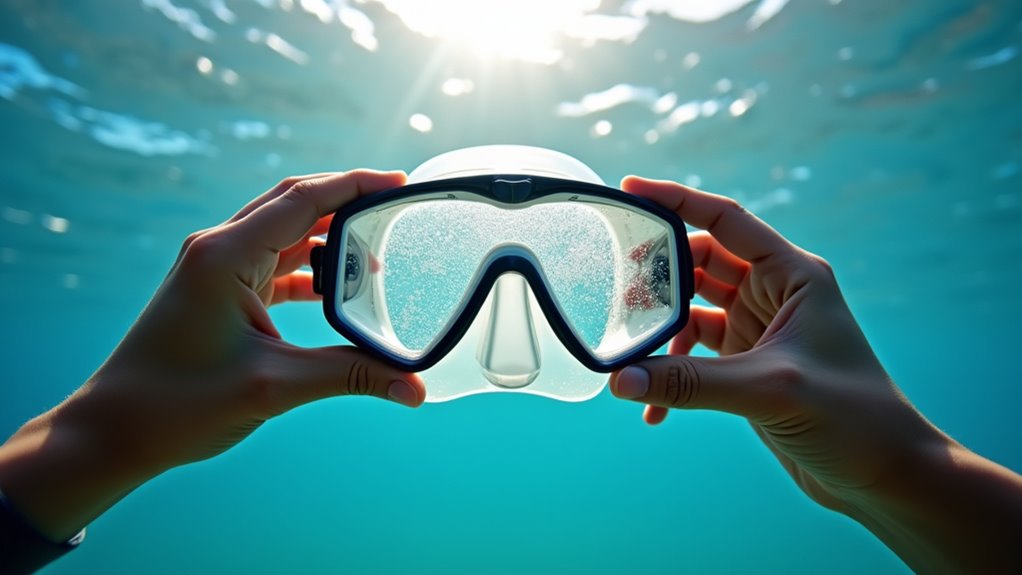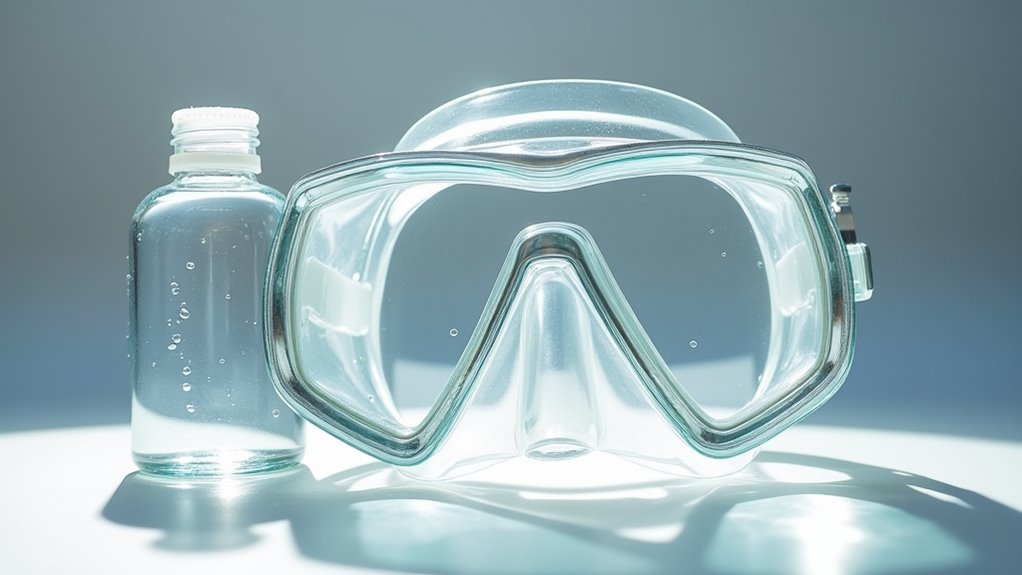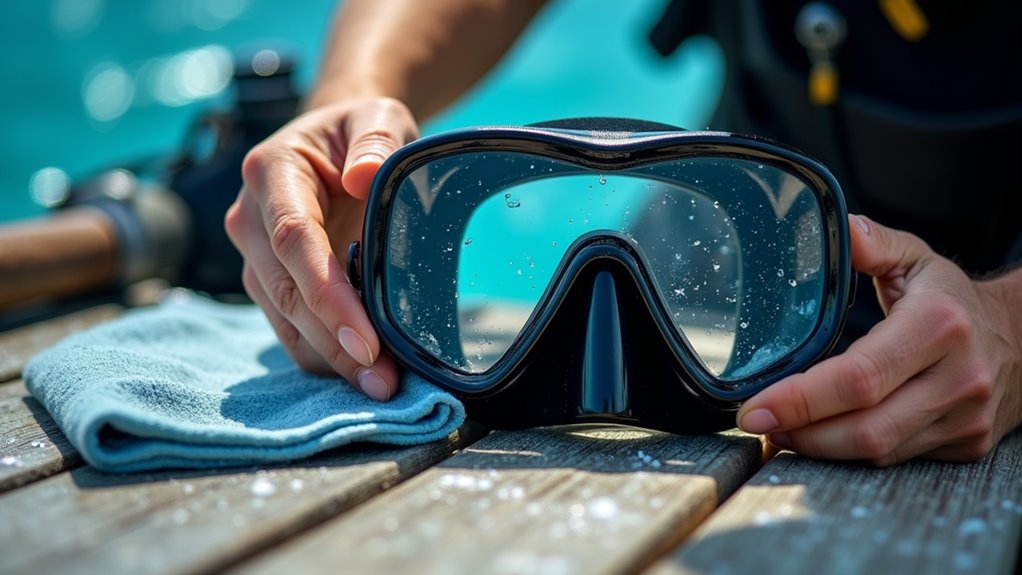Physical Address
304 North Cardinal St.
Dorchester Center, MA 02124
Physical Address
304 North Cardinal St.
Dorchester Center, MA 02124

Master the essential defogging techniques that prevent your diving mask from ruining underwater adventures—discover the secrets pros use.
You’ve probably experienced that frustrating moment when your diving mask fogs up just as you’re about to witness something incredible underwater. It’s one of those diving annoyances that can quickly turn an amazing dive into a blurry disappointment. The good news? You can easily prevent this problem with a few simple techniques that every diver should master. Once you understand what causes fogging and learn the most effective prevention methods, you’ll never have to miss another underwater moment again.

When you descend into the underwater world, that annoying fog creeping across your mask’s lens happens because of a simple temperature difference. Your warm breath and body heat create moisture inside the mask, while the cooler water temperature outside causes condensation to form on the glass surface.
Think of it like stepping into an air-conditioned building on a hot summer day – your sunglasses instantly fog up. The same physics apply underwater. The greater the temperature difference between your warm face and the cold water, the more severe the fogging becomes.
Plus, any residual oils, lotions, or cleaning residue on your mask’s interior surface provide nucleation points where water droplets can form more easily, making the problem worse.
Checking weather conditions before your dive can help you anticipate how much fogging to expect based on water temperature variations.
Fortunately, you can prevent most fogging issues before you even enter the water with proper mask preparation. Start by giving your mask lens a thorough cleaning with toothpaste – the mildly abrasive formula removes manufacturing residues and oils that promote fogging. Rub it gently across both sides of the glass, then rinse completely.
Next, apply a commercial anti-fog solution or create your own using baby shampoo mixed with water. Spread it evenly across the lens interior, let it sit briefly, then rinse lightly – you want a thin film to remain.
Some divers swear by the saliva method: simply spit on the lens, rub it around, and rinse gently. Whatever technique you choose, don’t skip this essential step.
If you’re planning a diving trip that requires boat transportation, consider whether renting or buying a vessel makes more financial sense for your diving adventures.

The market offers several reliable anti-fog products specifically designed for diving masks, and investing in quality solutions can make the difference between a crystal-clear dive and constantly clearing your vision underwater.
Sea Drops and McNett Sea Gold consistently rank as top performers among experienced divers. These concentrated formulas create a thin, invisible barrier that prevents condensation buildup. You’ll apply just a small drop, spread it evenly across your lens, then rinse lightly before diving.
Gear Aid’s Sea Quick is another proven option that works instantly without pre-dive preparation. Simply spray it on and you’re ready to go.
Avoid generic bathroom mirror products—they’re not formulated for underwater pressure and saltwater conditions. Stick with marine-specific brands that understand diving environments and you’ll enjoy fog-free visibility throughout your entire dive.
Just like selecting the perfect camping style requires asking the right questions about your preferences and needs, choosing anti-fog products works best when you consider your specific diving conditions and experience level.
While commercial products deliver reliable results, several household items can effectively defog your mask when you’re in a pinch or prefer budget-friendly alternatives.
Baby shampoo works exceptionally well—mix one part shampoo with ten parts water in a small bottle. Apply this solution to your dry mask lens, rub gently, then rinse lightly. The mild surfactants prevent condensation without irritating your eyes.
Toothpaste can serve as an emergency solution. Use non-gel, non-whitening varieties and apply sparingly to avoid scratching your lens. Rub thoroughly, then rinse completely.
Dish soap offers another reliable option when diluted properly. Mix a few drops with water and follow the same application method.
Raw potato also works—cut a slice and rub it directly on clean, dry glass before rinsing.
When preparing for diving excursions, pack these DIY solutions alongside other first aid items to ensure you’re ready for any underwater adventure.

Beyond applying defogging solutions before each dive, maintaining your mask properly will extend its lifespan and keep it performing at its best.
After each dive, rinse your mask thoroughly with fresh water to remove salt, sand, and chlorine that can damage the silicone and glass over time.
Fresh water rinses after every dive prevent salt, sand, and chlorine from gradually degrading your mask’s silicone and glass components.
Store your mask in a protective case or pouch to prevent scratches on the lens. Avoid leaving it in direct sunlight for extended periods, as UV rays can degrade the silicone skirt and cause it to become brittle.
Inspect your mask regularly for cracks, tears, or loose straps. Replace worn components immediately to maintain a proper seal.
Clean the lens occasionally with mild soap to remove stubborn residue, but avoid harsh chemicals that could damage anti-reflective coatings.
Just as camping water filters are essential for ensuring safe drinking water during outdoor adventures, proper mask maintenance is crucial for safe and enjoyable diving experiences.
You’ve got the tools and techniques to banish fogged masks forever. Whether you’re reaching for commercial anti-fog solutions or grabbing that trusty tube of toothpaste, consistency is your underwater ally. Don’t let a cloudy lens steal the magic of your dive – those vibrant coral gardens and curious sea creatures are waiting for your clear-eyed wonder. Keep up with regular maintenance, and you’ll enjoy crystal-clear views on every single underwater adventure ahead.